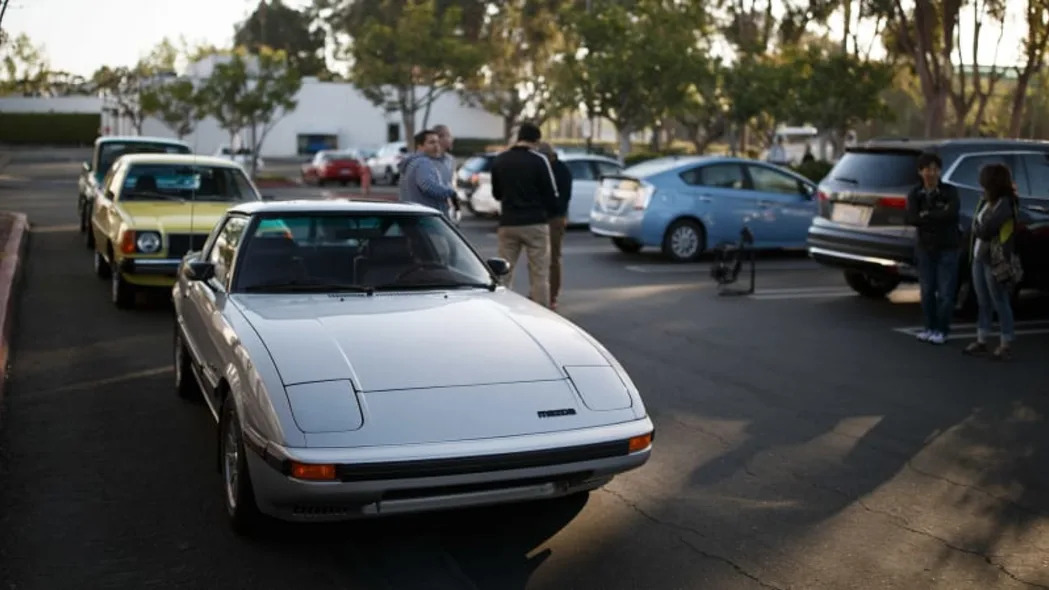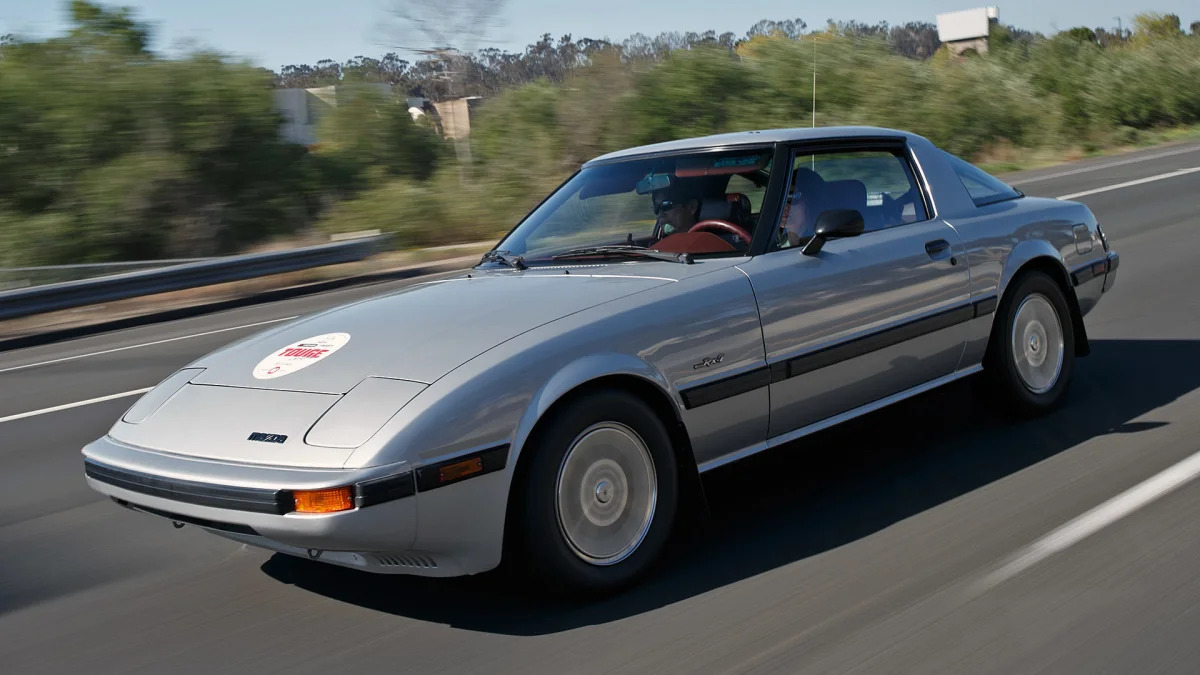What's so good about the future? This is what I was thinking when some folks at Mazda invited me and a handful of other journalists to join them on the second-annual Touge California. It's a rally for classic Japanese cars that covers a huge chunk of Southern California's twistier roads, where fans get to test their beloved machines. Oh, and it attracts swarms of admirers with cameras.
"It is not a race. It is a vintage touring rally," said Ben Hsu, editor in chief of Japanese Nostalgic Car, and one of the coordinators of the event. "In Japan, touge most definitely refers to racing, whether timed, in touge battles, or drifting antics. Touge California was created to give drivers of Japanese classics a taste, as close as possible, of the types of roads their cars were forged on."
The group of Mazdas was joined in Escondido by many more Mazdas. And Toyotas, Hondas, Datsuns – so many 240Zs – and the odd Subaru and Mitsubishi. In total, 28 cars were at the start line.
"We doubled the field this year, and made the route longer – 200 versus 120 miles," Hsu said. "We separated the cars into two run groups based on speed and a mix of makes and models."
I spent the first part of the rally in the Mazda pickup to get a taste of rotary power. It was my first experience behind the wheel of a Wankel-powered vehicle, my first time driving a small Japanese truck from the '70s, and my God that thing has a lot of power. I had a few scares when I had to stand on the brakes, and I found the shift throw's immense length disconcerting – it felt like third gear engaged somewhere in front of the dashboard, with fourth somewhere in the bed.
The truck was a great introduction to the rotary, however, and to '70s Japanese cars. Especially in Southern California, old Japanese cars aren't as novel to casual observers as they might be in other parts of the country. Cars don't rust nearly as quickly, a 35-year-old Mazda RX-7 doesn't look as out of place on the roads of Los Angeles as it would in the Midwest. I'm sure there's a rusty-but-running example five blocks from me right now.

Many of those who traveled from as far away as Arizona, New Mexico, and the central coast of California were reliving some dream or youthful fantasy. One man with a first-generation Celica GT sporting a six-cylinder engine transplant said he'd never been without a Celica since high school. Another brought along a Toyota Century, complete with doilies on the seats and an incomprehensible set of HVAC controls, but with the most stately appearance and silent engine that made anyone riding in the back look like an ambassador – even at a Shell station.
And the fans can appreciate a well-preserved example. While driving the RX-7, we met a young man in an early Miata. His face lit up as we pulled alongside him in quite possibly the cleanest and best-preserved '85 RX-7 GSL-SE around. He knew exactly what he was looking at – a car most people would take for granted, but something special to him. His girlfriend, however, was less amused that his eyes had moved away from her and the overlook and onto the silver Mazda.
By the end of the day, my co-driver and I were exhausted. Heavy Pacific Coast Highway traffic, and the fact deep automotive conversation and reading directions don't mix, meant we arrived back at Mazda's HQ later than anticipated. Exhausting, but ultimately thrilling. Four cars bowed out of the rally, but there were few other maladies along the trip. At the end, there wasn't so much amazement that the cars made the 200-ish mile trip but an admiration and reminder that classic cars don't need American V8s and chrome to be worthwhile.
A classic car is an iconic car, and that's largely what you have a picture of in your head. An RX-7, to a California native in their mid-20s, is typically viewed as a curbside fixture that will always be there, slightly sun-damaged. But with its equalizer and power antenna in working order, the beautifully slippery and flat red leather chairs and the impossible-to-find third gear, I fell in love with a somewhat attainable classic on roads I take for granted.
"Japan is 70 percent mountainous and full of touge roads," Hsu said. "And when you take that into consideration, it becomes obvious why Japanese automakers valued handling and lightness over all-out horsepower."
So when are you booking your trip to California?
Related Video:
"It is not a race. It is a vintage touring rally," said Ben Hsu, editor in chief of Japanese Nostalgic Car, and one of the coordinators of the event. "In Japan, touge most definitely refers to racing, whether timed, in touge battles, or drifting antics. Touge California was created to give drivers of Japanese classics a taste, as close as possible, of the types of roads their cars were forged on."
We started the day on a mundane stop-and-go freeway drive from Mazda's Irvine headquarters to Escondido, me riding shotgun with my journalist co-driver in a 2016 Miata. But Mazda also brought along three heritage products on this trip – a 1985 RX-7 GSL-SE, a 1978 GLC three-door hatchback, and a 1975 REPU (rotary engined pickup) – serving as reminders of the company's history in the U.S.Touge California was created to give drivers of Japanese classics a taste, as close as possible, of the types of roads their cars were forged on.
The group of Mazdas was joined in Escondido by many more Mazdas. And Toyotas, Hondas, Datsuns – so many 240Zs – and the odd Subaru and Mitsubishi. In total, 28 cars were at the start line.
"We doubled the field this year, and made the route longer – 200 versus 120 miles," Hsu said. "We separated the cars into two run groups based on speed and a mix of makes and models."
I spent the first part of the rally in the Mazda pickup to get a taste of rotary power. It was my first experience behind the wheel of a Wankel-powered vehicle, my first time driving a small Japanese truck from the '70s, and my God that thing has a lot of power. I had a few scares when I had to stand on the brakes, and I found the shift throw's immense length disconcerting – it felt like third gear engaged somewhere in front of the dashboard, with fourth somewhere in the bed.
The truck was a great introduction to the rotary, however, and to '70s Japanese cars. Especially in Southern California, old Japanese cars aren't as novel to casual observers as they might be in other parts of the country. Cars don't rust nearly as quickly, a 35-year-old Mazda RX-7 doesn't look as out of place on the roads of Los Angeles as it would in the Midwest. I'm sure there's a rusty-but-running example five blocks from me right now.

Many of those who traveled from as far away as Arizona, New Mexico, and the central coast of California were reliving some dream or youthful fantasy. One man with a first-generation Celica GT sporting a six-cylinder engine transplant said he'd never been without a Celica since high school. Another brought along a Toyota Century, complete with doilies on the seats and an incomprehensible set of HVAC controls, but with the most stately appearance and silent engine that made anyone riding in the back look like an ambassador – even at a Shell station.
And the fans can appreciate a well-preserved example. While driving the RX-7, we met a young man in an early Miata. His face lit up as we pulled alongside him in quite possibly the cleanest and best-preserved '85 RX-7 GSL-SE around. He knew exactly what he was looking at – a car most people would take for granted, but something special to him. His girlfriend, however, was less amused that his eyes had moved away from her and the overlook and onto the silver Mazda.
By the end of the day, my co-driver and I were exhausted. Heavy Pacific Coast Highway traffic, and the fact deep automotive conversation and reading directions don't mix, meant we arrived back at Mazda's HQ later than anticipated. Exhausting, but ultimately thrilling. Four cars bowed out of the rally, but there were few other maladies along the trip. At the end, there wasn't so much amazement that the cars made the 200-ish mile trip but an admiration and reminder that classic cars don't need American V8s and chrome to be worthwhile.
A classic car is an iconic car, and that's largely what you have a picture of in your head. An RX-7, to a California native in their mid-20s, is typically viewed as a curbside fixture that will always be there, slightly sun-damaged. But with its equalizer and power antenna in working order, the beautifully slippery and flat red leather chairs and the impossible-to-find third gear, I fell in love with a somewhat attainable classic on roads I take for granted.
"Japan is 70 percent mountainous and full of touge roads," Hsu said. "And when you take that into consideration, it becomes obvious why Japanese automakers valued handling and lightness over all-out horsepower."
So when are you booking your trip to California?
Related Video:










Sign in to post
Please sign in to leave a comment.
Continue